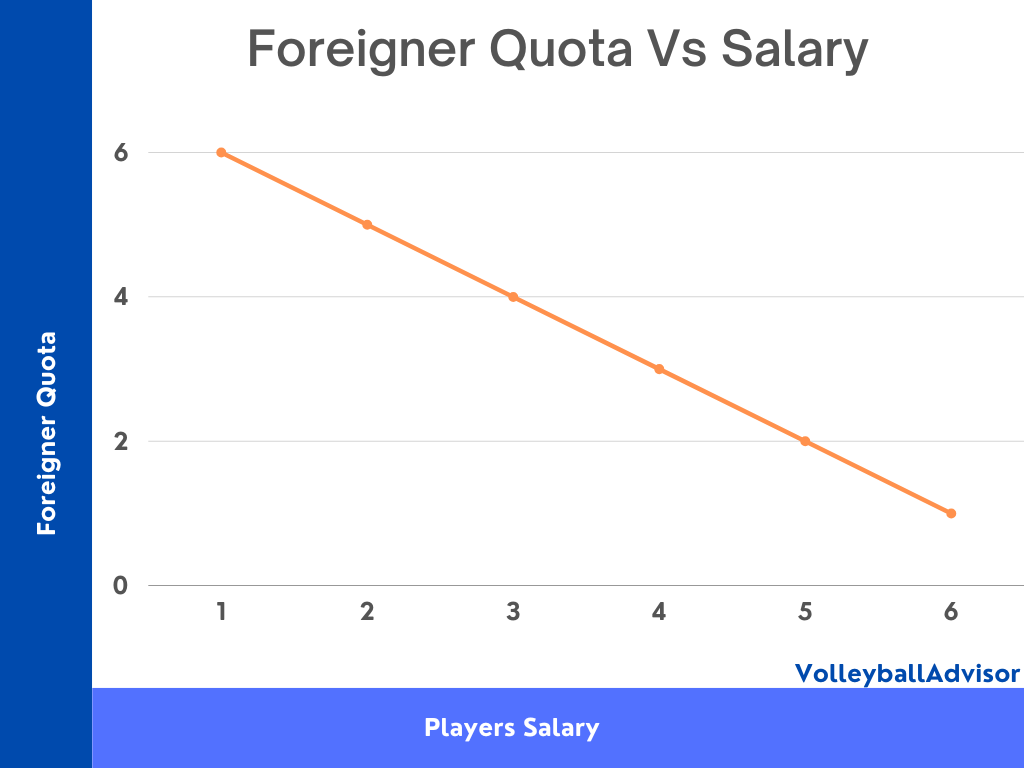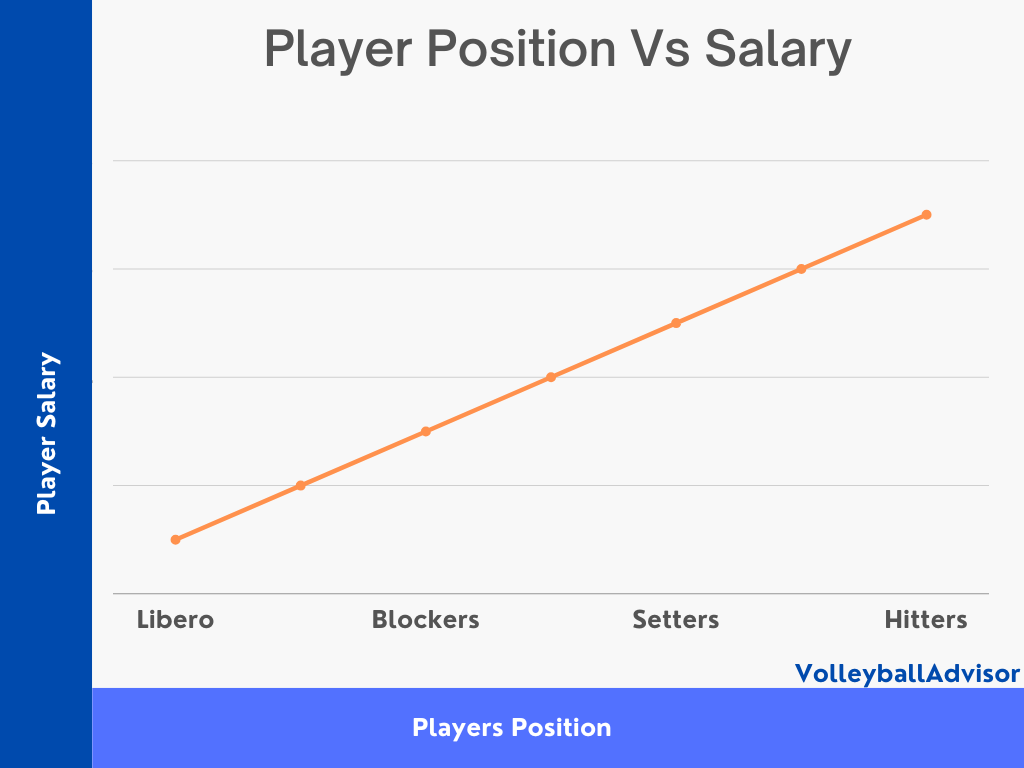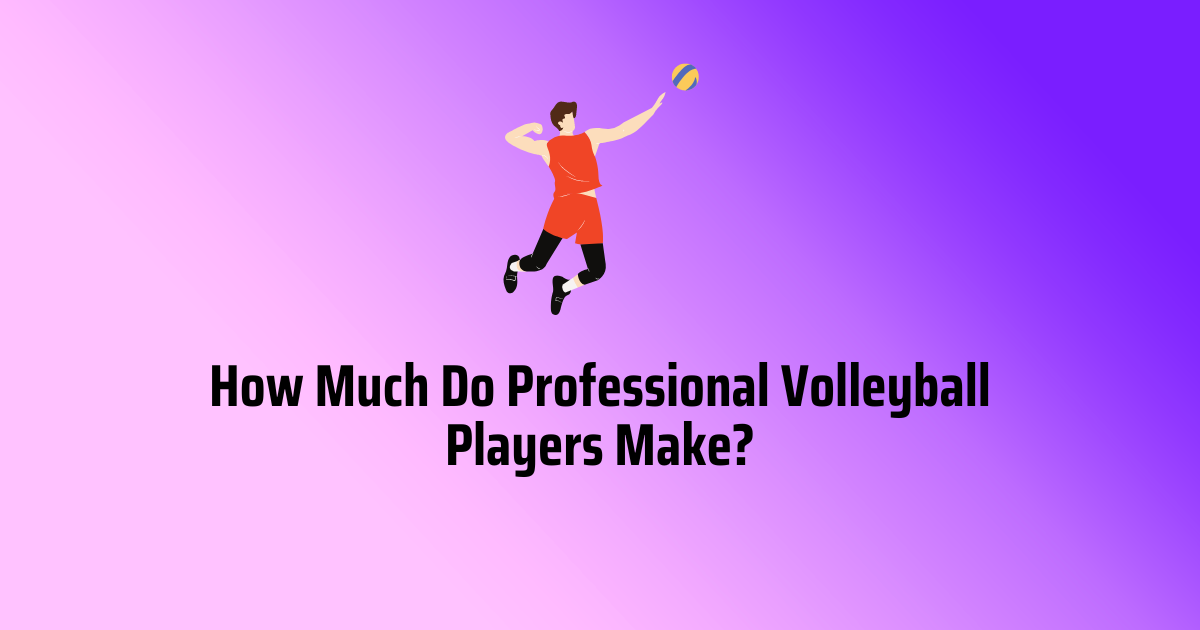Professional volleyball is a popular and exciting sport played at various levels worldwide, from local clubs to international competitions.
The sport features skilled athletes showcasing their talent, dedication, and teamwork in fast-paced matches.
As the sport continues to grow in popularity, more players are entering the professional arena, making a living from their athletic abilities.
With the increasing attention on professional volleyball, it is essential to understand the financial aspects of the sport, particularly players’ earnings.
Entry-level players typically earn between $12,000 and $55,000 per year, while seasoned professionals with a proven track record can command salaries over $100,000 annually. The world’s top volleyball players, who demonstrate exceptional talent and are highly sought after by clubs and national teams, can earn over $1 million per year.
It also sheds light on the challenges athletes face, the impact of gender disparities, and the opportunities for future generations to pursue a career in professional volleyball.
Here I am going to share an in-depth analysis of the earnings of professional volleyball players, covering various factors that influence their salaries.
Is There A Professional Volleyball League?
Yes, there are several professional volleyball leagues worldwide where players compete at a high level and earn a living playing the sport.
These leagues typically consist of club teams from various cities or regions within a country. The level of competition, popularity, and player salaries can vary significantly between leagues and countries.
Some of the most prestigious and competitive professional volleyball leagues include:
- Italy’s Serie A1
- Russia’s Super League
- Brazil’s Superliga
- China’s Volleyball League
- Japan’s V.League
- Turkey’s Turkish Volleyball League
- Poland’s PlusLiga
- France’s Ligue A
- Germany’s Bundesliga
In addition to domestic leagues, there are also international club competitions, such as the FIVB Volleyball Club World Championship, where the top club teams from around the world compete against each other.
Factors Influencing Volleyball Players’ Salaries
Understanding the various factors that influence the salaries of professional volleyball players is essential in gaining a comprehensive view of the financial aspects of the sport. From geographic location and level of play to experience performance and even gender, numerous elements play a role in determining a player’s income.
Foreigner Quota
Foreigner quotas are one of the most significant factors influencing how much a volleyball player can earn in different leagues around the world.
Each league has its own rules regarding the number of foreign players allowed to sign contracts with clubs.
Generally, the fewer foreign players a league permits, the higher the salaries for those players, as clubs compete for top international talent.
| Country | League | Foreigner Quota |
|---|---|---|
| Italy | Serie A1 | 4 |
| Russia | Super League | 2 |
| Brazil | Superliga | 2 |
| China | Chinese Volleyball League | 4 |
| Japan | V.League | 4 |
| Turkey | Turkish Volleyball League | 2 |
| South Korea | Korean V-League | 1 |
| Poland | PlusLiga | No specific quota |
| France | Ligue A | 3 |
| Germany | Bundesliga | No specific quota |
For instance, the Russian Super League has a foreigner quota of just 2 players per team, and the Polish PlusLiga allows 3 foreign players per team.
These limitations create a higher demand for elite foreign players, often leading to higher salaries for those athletes.
In contrast, the French Ligue A has a more generous foreigner quota of 6 players per team, while Germany’s Bundesliga has no specific quota, subject to certain regulations.

In these leagues, the increased supply of foreign players may result in relatively lower salaries compared to leagues with stricter quotas.
Understanding the foreigner quotas in various leagues is crucial when evaluating the earning potential of professional volleyball players and the factors that contribute to their salaries.
Domestic and international leagues
The country and league in which professional volleyball player competes greatly influence their earnings.
Some domestic leagues, such as Italy’s Serie A1, Russia’s Super League, and Brazil’s Superliga, offer higher salaries than others due to their competitive nature and strong financial backing.
International leagues may also provide lucrative opportunities for top players, who often play for clubs in countries other than their own to maximize their earnings.
Club vs National Team
The level of play is another crucial factor that impacts a player’s earnings. Club teams typically provide a more consistent income source, with players earning a salary throughout the season.
National team players, on the other hand, may receive additional income from their respective countries, including bonuses and incentives for representing their nation in international competitions.
Players’ positions
A player’s position on the court can significantly impact their earnings in professional volleyball.

High Salaries for Premier Outside and Opposite Hitters
Outside and opposite hitters tend to receive the highest salaries due to their pivotal roles in scoring points and contributing to the team’s success.
These star players are often in high demand, and clubs are willing to invest in their talents to secure wins.
Key Stats
- Wilfredo Leon, who is currently the highest-paid professional men’s volleyball player, is an outside hitter. He signed a contract for $1.58 million with his club in Perugia, Italy.
- Outside hitter, South Korean volleyball star Kim Yeon-koung has re-signed with the Heungkuk Life Pink Spiders, on a one-year deal worth $590,000.
Liberos: The Often Underappreciated Role in Volleyball Salaries
On the other hand, liberos, despite being essential to the team’s defense and ball control, are typically the least valued position in terms of salary.
While they play a crucial role in maintaining the team’s stability and flow, their contributions might not be as visible or celebrated as those of the high-scoring hitters.
Consequently, liberos may earn comparatively lower salaries than their teammates in more prominent positions.
Experience and performance
A player’s experience and performance significantly impact their salary. Seasoned players with a proven track record of success generally command higher wages than rookies and less experienced players. As players demonstrate their skills and contribute to their team’s success, their salaries may increase over time.
Skill Level
Indeed, a player’s skill level plays a vital role in determining their potential earnings in professional volleyball.
How proficient you are at the sport can influence the interest of various leagues, coaches, and agents who may want to sign you into a contract.
In Europe, leagues are classified into four tiers based on the skill level and quality of competition.
Tier 1 leagues, which include Italy, Russia, Poland, and Brazil, have the highest level of play and are considered the most competitive.
These leagues often have lower foreigner caps, which means teams must recruit international talent judiciously. As a result, they target top players and offer them lucrative contracts.
European League Skill Tiers:
| League | Tier | Salary Notation |
|---|---|---|
| Italy, Russia, Brazil, Poland | 1 | High |
| Argentina, France, Turkey | 2 | Moderate |
| Belgium, France B, Germany, Greece | 3 | Moderate-Low |
| Austria, England, Finland, Netherlands, Sweden, Switzerland | 4 | Low |
While Brazil is not in Europe, it is often considered a Tier 1 league due to the high level of competition.
From a financial standpoint, the Asian leagues could be included in Tier 1 as well, given the substantial salaries paid to foreign superstars.
However, it’s important to note that the overall level of play in these leagues is relatively lower than their European counterparts.
Understanding the influence of foreigner quotas and the various skill tiers among leagues is crucial when evaluating the earning potential of professional volleyball players.
A player’s skill level not only determines their contract value but also the leagues and clubs they are likely to attract.
Gender pay disparity
The gender pay gap is a persistent issue in professional volleyball, with male players typically earning more than their female counterparts. This disparity can be attributed to several factors, including the perception of men’s volleyball as more lucrative, differences in sponsorship opportunities, and a lack of investment in women’s volleyball compared to men’s.
Sponsorships and endorsements
Sponsorship and endorsement deals can greatly enhance a professional volleyball player’s earnings. Top players often sign lucrative contracts with major brands, which provide them with additional income and visibility. Factors such as performance, popularity, and marketability play a significant role in determining the value of these deals, with well-known athletes commanding higher fees.
Salary Ranges in Professional Volleyball
Entry-level players
Entry-level players are those who are just starting their professional volleyball careers, often with little to no experience in top-tier leagues. Their salaries tend to be relatively low, ranging from a few thousand to tens of thousands of dollars per season. These players must prove their skills and dedication to the sport to advance in their careers and potentially earn higher salaries.
Mid-level professionals
Mid-level professionals are players who have gained some experience in professional leagues and have established themselves as valuable team members. Their salaries generally range from tens of thousands to low six figures per season. Factors such as the player’s position, performance, and league will influence their earnings within this range.
Star players
Star players are those who have demonstrated exceptional skills and have become key contributors to their team’s success. These players often command higher salaries, typically in the mid to high six-figure range per season. Star players are more likely to receive lucrative sponsorship and endorsement deals, further increasing their earnings.
International superstars
International superstars are the top-tier athletes in professional volleyball, often representing their countries in global competitions and playing for the most prestigious club teams. These players can earn salaries in the high six figures or even seven figures per season. In addition to their substantial salaries, international superstars often benefit from lucrative sponsorship and endorsement deals, as well as signing bonuses and incentives for their performance in international competitions.
Earnings in Top International Volleyball Leagues
Italy’s Serie A1
Italy’s Serie A1 is considered one of the top professional volleyball leagues in the world, attracting high-caliber players from around the globe.
Salaries in Serie A1 can range from around $30,000 per season for entry-level players to over $1 million for international superstars.
The average salary in Serie A1 is estimated to be around $100,000 to $150,000 per season.
Russia’s Super League
The Russian Super League is another elite volleyball competition, featuring top-tier talent from both Russia and abroad.
Players in this league can earn between $50,000 to over $1 million per season, with the average salary being approximately $150,000 to $200,000 per season.
Brazil’s Superliga
Brazil’s Superliga is a highly competitive volleyball league with a strong fan base and excellent talent.
Salaries in the Superliga can vary greatly, with entry-level players earning around $20,000 per season and top players commanding over $500,000 per season.
The average salary in the Brazilian Superliga is estimated to be around $60,000 to $80,000 per season.
China’s Volleyball League
The Chinese Volleyball League has grown in prominence in recent years, attracting both domestic and international players.
Salaries in this league can range from $30,000 for entry-level players to over $1 million for top-tier talent.
The average salary in the Chinese Volleyball League is estimated to be around $100,000 to $200,000 per season.
Japan’s V.League
Japan’s V.League is another competitive volleyball league, featuring both domestic and international talent.
Player salaries in the V.League can range from $20,000 for entry-level players to over $500,000 for star athletes. The average salary in the V.League is estimated to be around $50,000 to $100,000 per season.
Turkey’s Turkish Volleyball League
The Turkish Volleyball League has gained a reputation as a competitive league, particularly in women’s volleyball.
Player salaries in this league can range from $15,000 for entry-level players to over $500,000 for top athletes. The average salary in the Turkish Volleyball League is estimated to be around $40,000 to $70,000 per season.
Prize Money from Tournaments and Championships
Olympic Games
The Olympic Games is the most prestigious international competition for volleyball players, held every four years.
While the International Olympic Committee (IOC) does not provide direct cash prizes for medal winners, individual countries often offer substantial bonuses for athletes who win gold, silver, or bronze medals.
These amounts vary by country and can range from tens of thousands to hundreds of thousands of dollars.
FIVB Volleyball World Championship
The FIVB Volleyball World Championship is another significant international tournament held every four years, featuring the top national teams from around the world. The prize money for this event is typically substantial, with the winning team often receiving several hundred thousand dollars. This amount is usually divided among the players, coaching staff, and the national volleyball federation.
FIVB Volleyball World Cup
The FIVB Volleyball World Cup is held every four years and serves as a qualifier for the Olympic Games. The prize money for this tournament is also considerable, with the winning teams receiving cash rewards that can be divided among the players and staff. The specific amounts can vary depending on the tournament’s overall budget and sponsorship deals.
Continental Championships
Continental championships, such as the European Championship, Asian Championship, and Pan American Games, also offer prize money for the top finishers. These amounts can vary depending on the specific competition and the financial resources of the organizing body. In general, the winning teams can expect to receive cash rewards that are distributed among the players and staff.
Domestic league championships
Domestic league championships, such as the Italian Serie A1, Russian Super League, and Brazilian Superliga, often feature prize money for the top teams. The amount of prize money can vary widely depending on the league’s financial resources and sponsorship deals. The winnings are typically divided among the team’s players, coaches, and staff.
Distribution of prize money among players
The distribution of prize money among players can vary depending on the specific tournament, team contracts, and national volleyball federation policies. In some cases, the prize money is divided equally among all team members, while in others, it may be allocated based on individual contributions or negotiated agreements. It’s essential to consider the distribution of prize money when evaluating the overall earnings of professional volleyball players, as it can represent a significant source of income for those who excel in high-stakes competitions.
How Much Do Professional Volleyball Players Make In Asia?
In the Asian volleyball leagues, players have the potential to earn impressive salaries, although securing a spot as a foreign player can be quite challenging.
The earning prospects for local and international players in these leagues vary significantly, depending on factors such as experience, skill level, and market demand.
For entry-level local professional men’s volleyball players in Asia, salaries typically range between $15,500 and $55,000 per year.
In the Prime Volleyball League, Rohit Kumar was the player with the highest bid. The Kochi Blue Spikers chose him for 17.5 lakhs (23k USD).
On the other hand, top local players can earn up to $530,000 per season, reflecting their higher skill level and increased value to their respective teams.
International superstar volleyball players have the potential to earn even more, with some commanding salaries north of $1 million per season while playing in Asian leagues.
The reason behind such lucrative earnings in the Korean, Japanese, and Chinese leagues can be attributed to the stringent foreigner quotas in these countries.
How Much Do Professional Volleyball Players Make In Japan?
The salaries of professional volleyball players in Japan can vary greatly depending on factors such as skill level, position, and available sponsorships.
For local entry-level players, the starting salary generally hovers around $15,500 per year. While this might not seem like a substantial sum, it’s essential to consider the additional benefits and support provided to these athletes.
In Japan, both men’s and women’s teams often offer team dormitories for their players. These accommodations not only help athletes save on living expenses, but they also foster team camaraderie and create a supportive environment for players to focus on their game.
In addition to housing, teams may also cover other amenities and necessities for their athletes, further reducing their financial burdens.
Conclusion
Volleyball players’ earnings are influenced by various factors, including geographic location, level of play, experience, gender, and sponsorship deals. While some players enjoy lucrative careers, many others face financial challenges and income disparities within the sport.
As the popularity of volleyball continues to grow worldwide, there is potential for increased investment, sponsorships, and media coverage, which could result in higher earnings for professional players.
This growth could also create more opportunities for aspiring athletes to pursue careers in the sport, both on and off the court.
